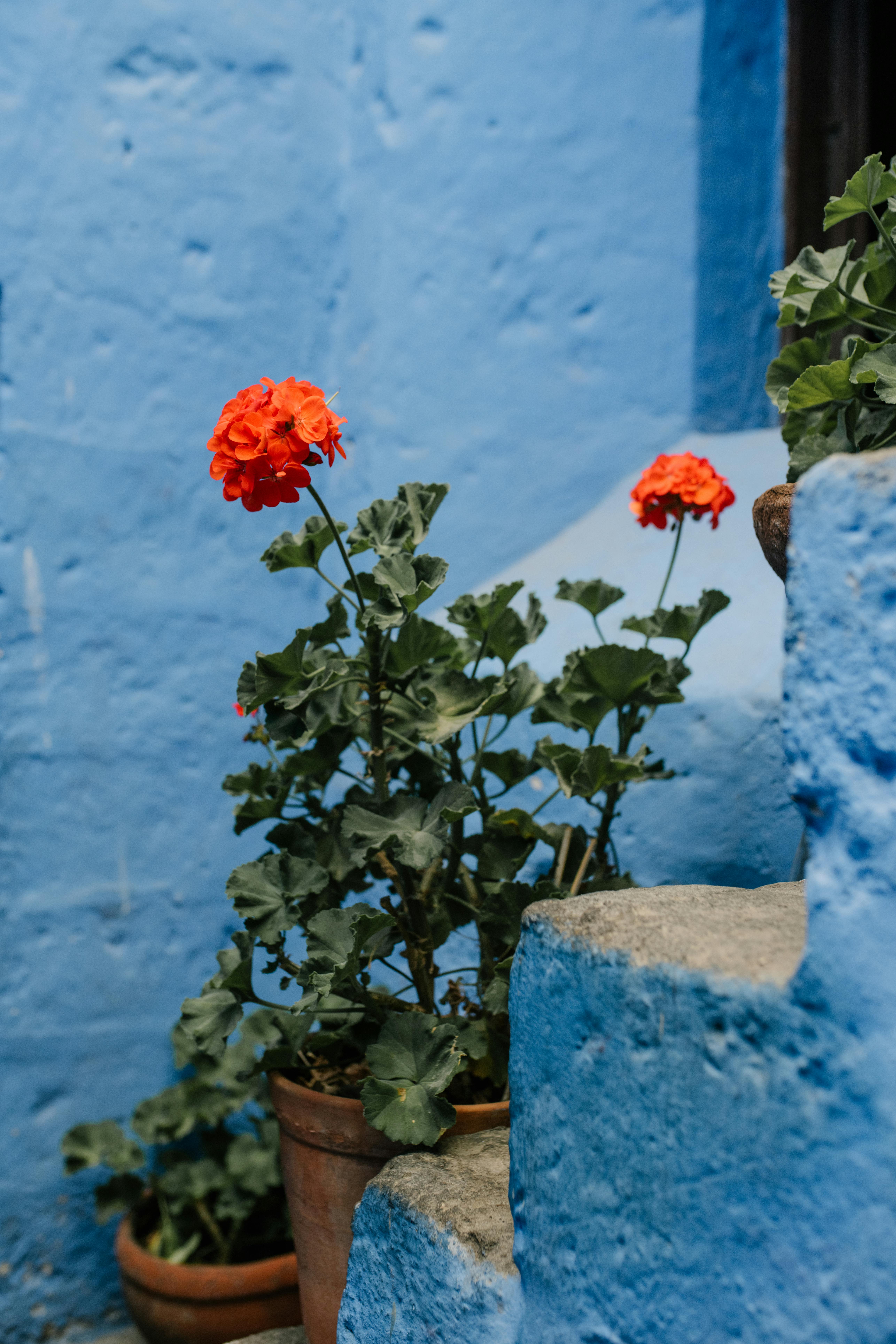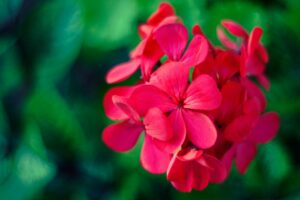Health Benefits Of Geranium Essential Oil: 422 Types Of ‘Cranesbill’

Geraniums are very popular flowers for use in gardening and decorating interiors. They have been used for similar reasons since the times of the ancient Greeks. The plant is also commonly referred to as the ‘cranesbill’ because of its crane-like shaped fruit capsules that house the seeds of the plant. There are many different varieties of the geranium that occur naturally in the wild, 422 to be exact, and they are often used by bee-keepers to help bees pollinate their hives with sweet and pungent nectar that makes for quite a popular honey.
A lot of us may have heard of or encountered edible flowers and Geraniums are indeed one of those species. However, I should make it clear at this point that not all Geraniums are edible. In fact it’s only the Rose Geranium genus that make good edible flowers. So don’t go chomping on the geraniums on your garden until you’re sure of which genus they belong to. Rose Geraniums can be easily acquired and they make terrific additions to almost any dessert, cake or pudding as they’re tasty and look great on your plate.
In fact, I’ve often experimented with my own small collection of Geraniums in the kitchen and only had good results – my guests would certainly agree! It’s not everyday that you get to eat a meal or dessert that pairs with edible flowers. They’ll be sure to add that extra bit of zest to your dish. If I had to relate the flowers to a spice (so that you could get an idea of how they taste), it would be something close to nutmeg.
A sweet, but slightly savory aroma, with musky, earthy hints. The flowers also make a great addition to your glühwein recipe and can really round off the texture and a taste of your brew – a fantastic addition to warm meals during cold winters or rainy days.
However, the beauty of these amazing flowers is not limited to their use in either the garden or the kitchen. They are also the source of a very potent natural essential oil that can help relieve you of a wide variety of illnesses, infections, and ailments that we generally treat with pharmaceutical products. Now, I’m sure most of you reading this have some understanding (or at least experience) with a variety of prescription drugs or over-the-counter remedies that you’ve picked up at your chemist in the past.
We’re all well aware of the many side-effects that most of these drugs come with – everything from headaches and nausea to stomach cramps and diarrhea (and in some cases, far worse).
We’re all about dissecting and explaining the amazing qualities of natural products that can be used to treat and cure your ailments without having to make use of harmful pharmaceutical products – in fact, trying to cut them out of your life as much as possible. Essential oils are a great way to tackle this issue, as they’re very potent and powerful, but are also safe and non-toxic, so will not cause you to get ill when using them (so long as you stick to a prescribed and regulated dosage).
They’re rapidly gaining popularity as an alternative means of treating most everyday forms of illness and even some more serious cases. So, if you’re interested in making the switch to a more holistic lifestyle and having a healthier body and state of mind – then keep scrolling!
How Is Geranium Essential Oil Made?

The plants tend to favor well-lit gardens with moist soil.
Geraniums are generally known as summery flowers that are native to Eastern parts of the Mediterranean and especially in South Africa. The plants tend to favor well-lit gardens with moist soil, so be sure to water them regularly if you’re planting them in your garden. The plants also grow very well as pot-plants and can be grown from the cuttings of other geraniums – meaning that once you nurture one, you can start an entire collection. This propagation and mass cultivation is easier than most other plants and it means that a steady supply of the essential oil can be provided at a relatively lower cost than most other oils. This is a key factor in why it’s one of the more popular essential oils on the market these days.
In fact, the Geranium is often referred to as the ‘poor man’s rose’ because they share many of the same chemical and nutrient properties with the rose. The oils even smell a bit like each other and they are commonly blended together for medicinal use and in aromatherapy.
The essential oil is not distilled from the flower of the geranium, but rather from the thick, slightly furry leaves of the plant and the stems. As I have mentioned many times in the past, the most effective way for one to distill essential oils from plants, flowers, and resins is a method that is known as steam distillation. It is one of the oldest means of distilling the oils from natural organisms and is still considered the best means of producing a pure extract that is free of chemicals and impurities.
To produce the essential oil in this way, the stems and leaves of the Geraniums are harvested and crushed in order to stimulate the release of their phytochemicals and nutrient properties. These are then added to a still that is filled with water which has been brought to a boil, or placed in a separate chamber that is connected to the boiling water.
As the water boils, steam is released. In the first instance of the distillation process, the boiling water extracts the various nutrients and chemicals from the organic material and is carried by vapor into a separate cooling chamber that is connected to a flask. Here, the vapor cools and condenses, forming droplets that gather in the flask as the pure oil extracts of the plant – ready for bottling or further distillation to produce different grades of the oil (although this is rare).
In the second instance, the same thing occurs except that the steam produced by the boiling water passes into the chamber containing the organic material. The steam itself then extracts the nutrients and phytochemicals in the organic material and carries it in vapor form to the cooling chamber where it condenses and forms the liquid form of the essential oil that is the finished product we buy in a vial. This oil is very potent and is meant for sparing uses. This is what makes it suitable for medicinal use and for treating ailments and illnesses.
Geranium Essential Oil For Skin And Acne
Geranium essential oil is a strong natural source of linalool, limonene and citronellol, which makes it highly effective as a natural skin cleanser and moisturizer. The oil has natural astringent properties, which means that it can be added to your daily facial cream (I’d recommend 2-3 drops) and applied to your face. It helps to tighten and lift the skin on your face as well as induce contraction on other parts of your body. So when applied regularly, it can help slow the aging process and even reduce the signs of wrinkles, stretch marks and scars on the surface of your skin – so it’s great to use after a pregnancy.
The Health Benefits Of Litsea Cubeba Essential Oil: Get Lit!
The oil also has strong anti-inflammatory, antioxidant and antiseptic properties and can be used to treat oily and acne prone combination skin types. It will help to remove excess sebum oil that often clogs or blocks one’s pores – leading to blemishes. It can also help by removing dead skin cells that happen naturally as our body regenerates and produces new skin cells – an ongoing process we cannot avoid. On top of this, the Geranium oil can also promote cell growth, which means that your skin will heal quicker, leaving you with a better complexion and less red, inflamed spots.
To apply the oil on a daily basis, I’d recommend adding the oil into your regular facial routine. To do this, wash your face first with a natural exfoliating face cream or scrub (you can use whichever product or means you’d like, but I’d recommend a simple sugar and canola oil scrub). Once you’ve removed the debris and dead skin cells with an exfoliator, apply 2 drops of oil to your skin with a clean cotton swab. You can also add 3-4 drops to a teaspoon of coconut oil or shea butter and rub it into the affected areas on your skin. Let the oil rest on your skin for about 5 minutes and then rinse your face with warm water and dry with a clean towel.
If you’re just applying the oil raw with a cotton swab, you don’t have to rinse with water – but I recommend removing all products from your skin if you have naturally oily skin as it can have a negative effect on your skin’s natural oil balance. Excessive oil, leads to a bad complexion, as I mentioned earlier.
Geranium Essential Oil For Ticks

It’s easy to make a natural DIY homemade insect repellent spray.
If you’re like me, then you love the outdoors. Spending time outside and away from the city is one of the best ways to calm down, relax and unwind. Get out of the home, breathe some fresh air and stay off your cellphone – basically, everything that causes you stress. However, one of the common downsides to being out in the wild are the bugs!
They’re small and somewhat harmless on their own, but being swarmed by a group of bugs or being bitten when you’re unaware of it can result in itchy, inflamed sores that really hurt and irritate you and they only get worse when you scratch them. So, as with most forms of medicine, it’s best to try and avoid being bitten in the first place. Geranium has a strong and potent odor that is high in citronellol and geraniol that helps to keep insects away (mosquitoes, ticks, and fleas) and helps prevent diseases that they often carry.
To make a natural and easy DIY homemade insect repellent spray, all you’ll need is:
- 1 Teaspoon of Olive oil.
- 1 ½ Tablespoon of Distilled water.
- 1 Teaspoon of Witch Hazel oil (can also be replaced with grain alcohol or even vodka).
- 20 drops of Geranium oil.
- 1 plastic spray bottle.
Note: this recipe increases to whichever amount you see fit, so long as you stick to this ratio.
To make the spray, all you have to do is pour the distilled water into the container, then add the carrier oil and witch hazel or alcohol. Then add the drops of essential oil and seal the container. Shake well to mix the ingredients and shake again before using the spray. All you have to do is spray the contents onto the exposed parts of your body when you’re out and about. Also, spray the areas that have insect bites as this will also help to moisturize your skin so that you’ll have a more pleasant experience outside.
10 Geranium Essential Oil Benefits For Healthy Skin & Uplifting Your Mood https://t.co/kTyvJqkOlR pic.twitter.com/rmUYw5RIeA
— Healthy Living & Fit (@josephsarahmall) August 5, 2017
What Does Geranium Essential Oil Smell Like?
As I mentioned in the opening paragraphs of the article, the Geranium has an odor that is similar to or relatable to nutmeg cloves and the Rose flower – something of a blend in between the two. It is sweet and floral like the rose, yet also pungently musky and almost minty in its undertones. It’s an easily blendable essential oil and works well with bergamot, rose oil, orange oil, peppermint oil, jasmine, lavender, tea tree and eucalyptus oil.
Side Effects Of Geranium Essential Oil?

If the oil gets into your eyes, be sure to wash your eyes out with warm water.
As with any essential oil, Geranium oil is a highly concentrated extract from a plant that is already quite potent in its natural form. It’s a strong natural source and variety of phytochemicals and rich nutrients that make it really effective as a natural insect repellent, skin care treatment and even to fight off internal infections and diseases caused by malicious bacteria. However, the highly concentrated essential oil also means that excessive use can have certain side-effects.
Firstly, when using any essential oil as a topical solution to inflamed or irritated skin, it’s important to use the oil in controlled patches on the surface of your skin first, as a means of testing if you might have an allergic reaction to the oil. Allergic reactions are rare, but I’d rather you be safe than sorry in this case. We wouldn’t want you to turn away from natural products entirely just because of one bad experience. Secondly, make sure you don’t get any of the oil into your eyes, as it will burn and cause general irritation. If this does happen, be sure to wash your eyes out with warm water or milk if you have any on hand and seek medical assistance as soon as possible.
Thirdly, and most importantly, we generally recommend that you stay away from essential oils whilst pregnant as they can have negative effects on your unborn child and in some cases, even cause a miscarriage. Although, miscarriages are incredibly rare and can only really happen when someone has serious allergies or takes a seriously excessive amount of essential oils – so you’re generally safe from that. But as a rule of thumb, try to stay away from them during pregnancy or use them in very small and controlled doses.
Conclusion
So, as you now know, those pretty little flowers growing in the garden aren’t just for decoration. They have more uses as really potent natural remedies to a wide variety of ailments that can affect anyone of us at any given time. In fact, some of the major uses for Geranium essential oil that I didn’t even touch on in this article are its uses as a metabolic stimulant, increasing weight loss whilst working out or exercising, treating nerve and muscle pains, helping to stop diarrhea and even combating viral infections such athlete’s foot and the herpes virus.
All this from just one essential oil is quite an impressive list if you ask me. Especially when you consider the fact that it’s a natural, organic and purely non-toxic treatment. That means that you can save money on all those costly pharmaceutical drugs and treatment schedules, and even reduce the number of times you find yourself in a doctor’s office – picking up another prescription for more drugs! Making the shift to a more natural and holistic lifestyle is a lot easier when you’re using natural and holistic products, so I’d highly recommend Geranium oil for the top of your next shopping list.

